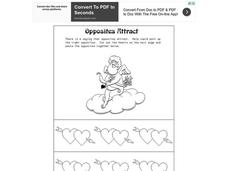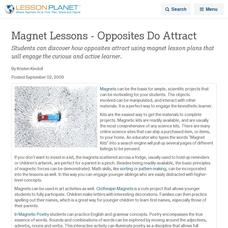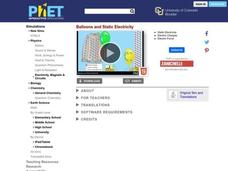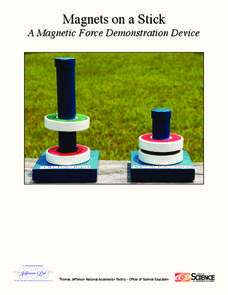EngageNY
The Opposite of a Number's Opposite
It's said that opposites attract, but what about opposites of opposites? Individuals learn about the opposite of opposites using number lines. They complete a group activity in which members determine the opposite of opposites of...
Concord Consortium
Opposites Attract
Whether they pull together or push away from one another, magnets are sure-fire pupil pleasers! Take their study of magnetism to a new level with a fun interactive. Individuals control the polarity of two spheres to observe attractive or...
Curated OER
Attract or Repel?
Opposites attract with a fun science experiment on magnets. With a short paragraph on background knowledge, the lab sheet prompts third and fourth graders to choose which pairs of magnets will attract, and which pairs will repel. A...
Curated OER
Opposites Attract
In this opposites attract worksheet, students help Cupid match up six sets of opposite words. Students cut out the opposite word sets on the second page and paste them on the hearts on the first page.
Curated OER
Magnet Lessons - Opposites Do Attract
Students can discover how opposites attract using magnet lesson plans that will engage the curious and active learner.
Curated OER
Opposites Attract (Elementary School)
Second graders generate a list of opposites found in the book, "Kaleidoscope of Kids". They use newspaper and magazine pictures to find opposites.
Curated OER
Why Opposites Attract: Observing Magnetic Fields
Students brainstorm background knowledge and any questions they may have about magnetic fields. They investigate the role that William Gilbert had in laying the groundwork for modern experimental science. Students observe magnetic fields...
Science Geek
Intermolecular Forces of Attraction
Chemists love London (dispersion forces)! Presentation begins with an explanation of intermolecular forces including hydrogen bonding, dipole-dipole attraction, and London dispersion forces. It also covers polarity and the relative...
Curated OER
Opposite Day
In this Opposite Day instructional activity, students complete activities such as reading a passage, matching phrases, fill in the blanks, choose the correct word, multiple choice, unscramble the words, sequencing, unscramble the...
Curated OER
Opposites Attract
Students demonstrate the attraction of small pieces of paper to a charged plastic rod and conduct experiment with other objects to determine whether they can hold a charge. They then use online applets to apply their experiments to...
Curated OER
Activity Plan 4-5: Opposites Attract!
Students experiment with magnets and sort objects based on magnetism. In this hands-on physical science instructional activity, the children are introduced to magnetism through discussion and experimentation and have the opportunity to...
Curated OER
Similarities Attract
Students research all the ways people seek their soulmates. The question if opposites attract or those with similar attractions is studied in depth. Compile all the many steps a scientist must often take to answer what looks like a...
EngageNY
Grade 10 ELA Module 3: Unit 2, Lesson 12
Opposites attract. Scholars choose one of their claims from the previous lesson. They then must consider the opposite view of that claim and create a counterclaim, discussing it with classmates. To help guide the discussion, they use a...
University of Washington
Using Modeling to Demonstrate Self-Assembly in Nanotechnology
Do polar opposites attract? After an introduction on the polarity of molecules, pupils are asked to design a self-assembling model using materials with different polarity. The challenge should motivate learners to develop a workable...
PhET
Balloons and Static Electricity
Like all electricity, static electricity flows at the speed of light, or 186,282 miles/second. The interactive simulation shows how like charges repel like charges and opposites attract. The user can choose either one or two balloons, a...
Bowels Physics
Magnetic Fields and Forces
Every knows that opposites attract! Here's a presentation that uses this background knowledge to explain magnetic fields and forces. The resource also explains the shape of magnetic fields and how to determine the direction of forces.
Concord Consortium
Dissolving Experimental
Why does like dissolve like? While in many cases opposites attract, the same cannot be said for chemistry! Solution scholars take an up-close look at the dissolving process with a customizable interactive. The resource allows users to...
US Department of Energy
Magnets on a Stick: A Magnetic Force Demonstration Device
Why do some magnets attract while others repel? Scholars use clearly labeled permanent magnets to explore the attractive question. They compare the behavior of like versus opposite poles to find the answer.
Curated OER
Opposites Attract
Students examine the properties of magnets and static electricity. They participate in experiments that demonstrate the behaviors of charged particles, and record their data on a worksheet.
Curated OER
Investigating Static Electricity
In this static electricity worksheet, students read about static electricity and how opposites attract. They investigate positive and negative charge by performing 2 experiments. They write their predictions about what will happen when...
K12 Reader
Magnetic Attraction
Teach your class about magnets and electromagnets with a reading passage. After reading the passage, learners respond to five related questions.
Curated OER
Teaching About Magnets in Kindergarten
Pupils explore magnets through the five lessons of this unit. The everyday uses of magnets and an awareness of magnetic attraction form the basis of the skills presented in these lessons.
Curated OER
ESL: Adjectives-Find the Opposite
In this ESL adjective worksheet, learners read adjectives, then choose their opposites from drop down lists beside each one. Answers can be checked on line.
Curated OER
Why is There a Tidal Bulge Opposite the Moon?
Students simulate how the Moon causes ocean tides. In this earth science lesson, students calculate gravitational acceleration using a mathematical formula. They compare the force of attraction between the Earth, Moon and Sun system.

























